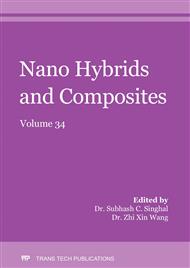[1]
J. B. Goodenough, Y. Kim, Challenges for Rechargeable Li Batteries, Chem. Mater. 22 (2010) 587-603.
Google Scholar
[2]
A. Manthiram, X. Yu, S. Wang, Lithium battery chemistries enabled by solid-state electrolytes, Nat. Rev. Mater. 2 (2017) 16103.
DOI: 10.1038/natrevmats.2016.103
Google Scholar
[3]
T. Famprikis, P. Canepa, J. A. Dawson, M. S. Islam, C. Masquelier, Fundamentals of inorganic solid-state electrolytes for batteries, Nat. Mater. 18 (2019) 1278-1291.
DOI: 10.1038/s41563-019-0431-3
Google Scholar
[4]
S. Kaboli, H. Demers, A. Paolella, A. Darwiche, M. Dontigny, D. Clement, A. Guerfi, M. L. Trudeau, J. B. Goodenough, K. Zaghib, Behavior of Solid Electrolyte in Li-Polymer Battery with NMC Cathode via in-Situ Scanning Electron Microscopy, Nano Lett. 20 (2020) 1607-1613.
DOI: 10.1021/acs.nanolett.9b04452
Google Scholar
[5]
S. Stramare, V. Thangadurai, W. Weppner, Lithium Lanthanum Titanates: A Review, Chem. Mater. 15 (2003) 3974-3990.
DOI: 10.1021/cm0300516
Google Scholar
[6]
J. van den Broek, S. Afyon, J. L. M. Rupp, Interface-Engineered All-Solid-State Li-Ion Batteries Based on Garnet-Type Fast Li+ Conductors, Adv. Energy Mater. 6 (2016) 1600736.
DOI: 10.1002/aenm.201600736
Google Scholar
[7]
S. Kim, H. Oguchi, N. Toyama, T. Sato, S. Takagi, T. Otomo, D. Arunkumar, N. Kuwata, J. Kawamura, S. I. Orimo, A complex hydride lithium superionic conductor for high-energy-density all-solid-state lithium metal batteries, Nat. Commun. 10 (2019) 1081.
DOI: 10.1038/s41467-019-09061-9
Google Scholar
[8]
L. Duchêne, A. Remhof, H. Hagemann, C. Battaglia, Status and prospects of hydroborate electrolytes for all-solid-state batteries, Energy Stor. Mater. 25 (2020) 782-794.
DOI: 10.1016/j.ensm.2019.08.032
Google Scholar
[9]
A. Sakuda, A. Hayashi, M. Tatsumisago, Interfacial Observation between LiCoO2 Electrode and Li2S−P2S5 Solid Electrolytes of All-Solid-State Lithium Secondary Batteries Using Transmission Electron Microscopy, Chem. Mater. 22 (2009) 949-956.
DOI: 10.1021/cm901819c
Google Scholar
[10]
N. Kamaya, K. Homma, Y. Yamakawa, M. Hirayama, R. Kanno, M. Yonemura, T. Kamiyama, Y. Kato, S. Hama, K. Kawamoto, A. Mitsui, A lithium superionic conductor, Nat. Mater. 10 (2011) 682-686.
DOI: 10.1038/nmat3066
Google Scholar
[11]
Y. Li, X. Wang, H. Zhou, X. Xing, A. Banerjee, J. Holoubek, H. Liu, Y. S. Meng, P. Liu, Thin Solid Electrolyte Layers Enabled by Nanoscopic Polymer Binding, ACS Energy Lett. 5 (2020) 955-961.
DOI: 10.1021/acsenergylett.0c00040
Google Scholar
[12]
Y. Kato, S. Hori, T. Saito, K. Suzuki, M. Hirayama, A. Mitsui, M. Yonemura, H. Iba, R. Kanno, High-power all-solid-state batteries using sulfide superionic conductors, Nat. Energy 1 (2016) 16030.
DOI: 10.1038/nenergy.2016.30
Google Scholar
[13]
T. Asano, A. Sakai, S. Ouchi, M. Sakaida, A. Miyazaki, S. Hasegawa, Solid Halide Electrolytes with High Lithium-Ion Conductivity for Application in 4 V Class Bulk-Type All-Solid-State Batteries, Adv. Mater. 30 (2018) 1803075.
DOI: 10.1002/adma.201803075
Google Scholar
[14]
X. Li, J. Liang, N. Chen, J. Luo, K. R. Adair, C. Wang, M. N. Banis, T.-K. Sham, L. Zhang, S. Zhao, S. Lu, H. Huang, R. Li, X. Sun, Water-Mediated Synthesis of a Superionic Halide Solid Electrolyte, Angew. Chem. Int. Ed. 58 (2019) 16427-16432.
DOI: 10.1002/anie.201909805
Google Scholar
[15]
X. Li, J. Liang, J. Luo, M. N. Banis, C. Wang, W. Li, S. Deng, C. Yu, F. Zhao, Y. Hu, T.-K. Sham, L. Zhang, S. Zhao, S. Lu, H. Huang, R. Li, K. R. Adaira, X. Sun, Air-stable Li3InCl6 electrolyte with high voltage compatibility for all-solid-state batteries, Energy Environ. Sci. 12 (2019) 2665-2671.
DOI: 10.1039/c9ee02311a
Google Scholar


